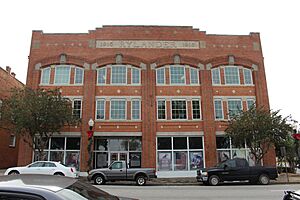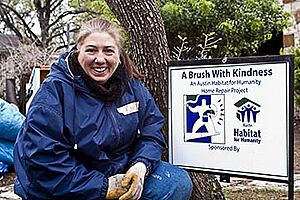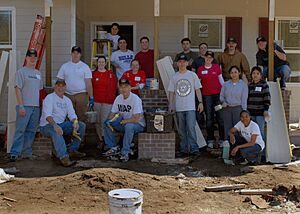Habitat for Humanity facts for kids
 |
|
| Founded | 1976 Americus, Georgia, U.S. |
|---|---|
| Founders | Millard Fuller Linda Fuller |
| Type | Non-profit, interest group, Christian |
| Location |
|
| Services | "Building simple, decent and affordable housing" |
| Fields | Protecting human rights |
|
Key people
|
Jonathan Reckford, CEO |
Habitat for Humanity International (often called Habitat for Humanity or just Habitat) is a Christian non-profit organization from the United States. It helps build and improve homes for families who need them. These homes are made to be simple, decent, and affordable.
Habitat for Humanity's main office is in Americus, Georgia, USA. Its administrative office is in Atlanta. As of 2023, Habitat for Humanity works in over 70 countries around the world.
The organization helps families who have low incomes or face challenges. Homes are built with the help of volunteers. This includes the families who will live in the homes, who contribute their own time and effort, known as "sweat equity." Sometimes, paid contractors are also hired for specific building tasks. Habitat for Humanity does not make any profit from selling these homes.
The organization gets money from many sources. These include individuals, charities, companies, governments, and media groups.
Contents
How Habitat for Humanity Started
Habitat for Humanity began with an idea from a lawyer named Millard Fuller and his wife, Linda. In 1968, they started something called the Humanity Fund. This was at Koinonia Farm, a Christian community in Georgia, USA.
With the money from this fund, 42 homes were built for families who needed them at Koinonia Farm. This showed that their idea could work.
In 1973, the Fullers took their idea to the Democratic Republic of Congo. They worked with a Christian mission there. After three successful years, the Fullers returned to the United States. In 1976, they officially founded Habitat for Humanity.
In 2022, in Tempe, Arizona, Habitat for Humanity used a new method. They used 3D printing to create walls for a house. This helped when there weren't enough workers available.
Special Programs
A Brush With Kindness
Habitat for Humanity has a program called A Brush With Kindness. This program helps homeowners with lower incomes. It focuses on keeping the outside of their homes in good shape.
Volunteers help these homeowners with outdoor tasks. This often includes painting, small repairs, and yard work. It also involves making homes more energy-efficient and cleaning up the outside. This program helps both families and their communities.
Local Groups (Affiliates)
Habitat for Humanity works through many local groups, called affiliates. These groups operate in different cities and regions.
Jacksonville, Florida
Habitat for Humanity of Jacksonville (known as HabiJax) is one of the largest Habitat for Humanity groups in the United States. In 2009, it was named one of the biggest homebuilders in the country.
HabiJax celebrated 35 years of service in 2023. It has helped over 2,300 families get homes.
HabiJax History
HabiJax was started in 1988 by nine church groups in Jacksonville. They received early funding from the Jessie Ball duPont Fund. Their first project was a house that was moved and fixed up for the first HabiJax family.
New York City and Westchester County
Habitat for Humanity New York City and Westchester County (Habitat NYC and Westchester) started in 1984. It helps families in New York City by building and preserving homes. Their first building was completed in December 1986.
In 1995, four different Habitat groups in New York City joined together. They formed one larger group, Habitat NYC. In 2020, this group expanded its work into Westchester County. It then became Habitat NYC and Westchester.
Other Special Projects
Habitat Bicycle Challenge
The Habitat Bicycle Challenge (HBC) was a special event that happened every year from 1995 to 2007. It was a nine-week bicycle trip across the United States. The goal was to raise money for Habitat for Humanity of Greater New Haven. It also aimed to make more people aware of Habitat for Humanity's mission.
Before the bike trip, participants spent seven months raising money. Once on the road, they rode about 4,000 miles. They also talked to people about Habitat's work. They often stayed with church groups and helped build homes with local Habitat chapters along their route.
At its peak, about 90 young people aged 18 to 24 joined the challenge each year. By 2004, HBC was the biggest yearly fundraiser for any Habitat group in the world. It raised about $400,000 a year. However, due to safety concerns, the Habitat Bicycle Challenge was stopped in September 2007.
Images for kids
-
Presidents over the years have supported the work of the organization.
-
HFH livery on a Delta aircraft allowing more awareness globally of affordable housing.
-
Global outreach event with NBA Cares.
See also
 In Spanish: Hábitat para la Humanidad para niños
In Spanish: Hábitat para la Humanidad para niños
- Habitat for Humanity Canada
- Habitat for Humanity Ireland
- Habitat for Humanity Uganda
- Habitat for Humanity Armenia












